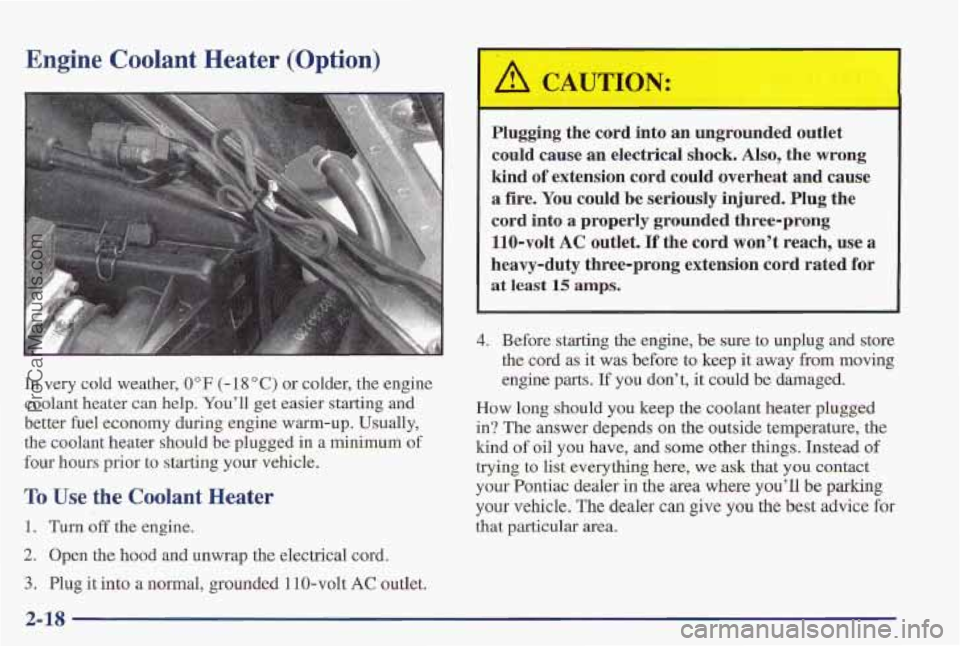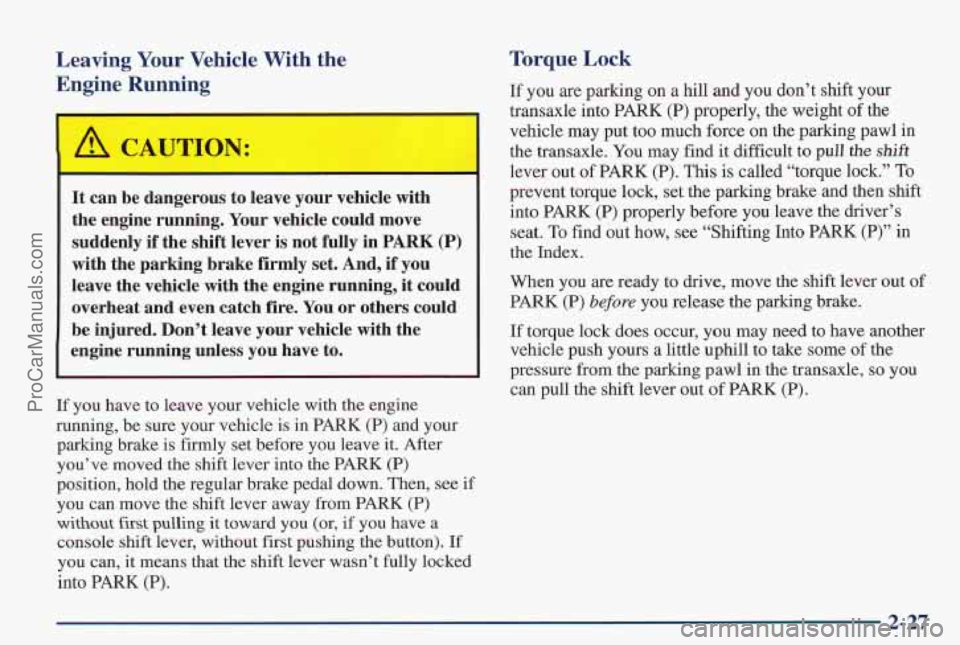1997 PONTIAC PONTIAC engine
[x] Cancel search: enginePage 92 of 419

Engine Coolant Heater (Option)
In very cold weather, 0°F (- 18 “C) or colder, the engine
coolant heater can help. You’ll get easier starting and
better €uel economy during engine warm-up. Usually,
the coolant heater should be plugged in a
minimum of
four hours prior to starting your vehicle.
To Use tl Coolant Heater
1. Turn off the engine.
2. Open the hood and unwrap the electrical cord.
3. Plug it into a normal, grounded 110-volt AC outlet.
Plugging the cord into an ungrounded outlet
could cause an electrical shock.
Also, the wrong
kind
of extension cord could overheat and cause
a fire. You could be seriously injured. Plug the
cord into a properly grounded three-prong
110-volt
AC outlet. If the cord won’t reach, use a
heavy-duty three-prong extension cord rated for
at least 15 amps.
4. Before starting the engine, be sure to unplug and store
the cord
as it was before to keep it away from moving
engine parts.
If you don’t, it could be damaged.
How long should you keep the coolant heater plugged
in? The answer depends on the outside temperature, the
kind of oil you have, and some other things, Instead of
trying to list everything here, we ask that you contact
your Pontiac dealer in the area where you’ll be parking
your vehicle. The dealer can give you the best advice for
that particular area.
2-18
ProCarManuals.com
Page 93 of 419

Automatic Transaxle Operation
Your automatic transaxle may have a shift lever on the
steering column
or on the console between the seats.
Maximum engine speed is limited when you’re in
PARK (P) or NEUTRAL (N), to protect driveline
components from improper operation. There
are several different positions for your shift lever.
PARK (P): This locks your front wheels. It’s the best
position to use when you start your engine because your
vehicle can’t move easily.
I
It is dangerous to get out of your vehicle if the
shift lever is not fully in PARK (P) with the
parking brake firmly set. Your vehicle can roll.
Don’t leave your vehicle when the engine is
running unless you have to.
If you have left the
engine running, the vehicle can move suddenly.
You or others could be injured.
To be sure your
vehicle won’t move, even when you’re
on fairly
level ground, always set your parking brake and
move the shift lever to
PARK (P).
See “Shifting Into PARK (P)” in the Index. If
you’re pulling
a trailer, see “Towing a Trailer” in
the Index.
ProCarManuals.com
Page 94 of 419

Make sure the shift lever is fully into PARK (P) NEUTRAL (N): In this position, your engine
range before starting the engine.
Your Pontiac has a doesn’t connect with the wheels. To restart when you’re
brake-transaxle shift interlock.
You must fully apply already moving, use NEUTRAL (N) only. Also, use
your regular brakes before
you can shift from PARK (P) NEUTRAL (N) when your vehicle is being towed.
when the ignition is in
RUN. If you cannot shift out of
PARK (P), ease pressure on the shift lever by pushing
it all the way into PARK (P) while keeping the brake
pedal pushed down. Release the shift lever button
if you
have a console shift. Then move the shift lever out of
PARK (P), being sure to press the shift lever button
if you have a console shift. See “Shifting Out of
PARK (P)” in the Index.
REVERSE (R): Use this gear to back up.
Shifting out of PARK (P) or NEUTRAL (N) while
your engine is “racing” (running at high speed)
is
dangerous. Unless your foot is firmly on the
brake pedal, your vehicle could move very
rapidly.
You could lose ‘control and hit people
I 1 I or objects. Don’t shift out of PARK (P) or I
NOTICE: NEUTRAL (N) while your engine is racing.
~ -
I Shifting to REVERSE (R) while your vehicle is I
moving forward could damage your transaxle.
Shift
to REVERSE (R) only after your vehicle
is stopped. NOTICE:
I I I I Damage to your transaxle caused by shifting out
To rock your vehicle back and forth to get out of snow,
ice
or sand without damaging your transaxle, see racing isn’t covered by your warranty. I
of PARK (P) or NEUTRAL (N) with the engine
“Stuck: In Sand, Mud, Ice or Snow” in the Index,
~ ~~
2-20
ProCarManuals.com
Page 95 of 419

AUTOMATIC OVERDRIVE (D): This position is for
normal driving.
If your vehicle has overdrive, AUTOMATIC
OVERDRIVE
(D) is the overdrive position. If you need
more power for passing, and you’re:
Going less than 35 mph (55 km/h), push your
0 Going about 35 mph (55 kmh) or more, push the
accelerator
pedal about halfway down.
accelerator pedal all the way down.
You’ll
shift down to the next gear and have more power.
NOTICE:
If your vehicle seems to start up rather slowly,
or
if it seems not to shift gears as you go faster,
something may be wrong with
a transaxle system
sensor.
If you drive very far that way, your
vehicle can be damaged.
So, if this happens, have
your vehicle serviced right
away. Until then, you
can use SECOND
(2) when you are driving less
than 35 mph (55 km/h) and AUTOMATIC
OVERDRIVE (D) for higher speeds. THIRD
(3): This
position is also used for normal
driving, but it offers more power and lower fuel
economy than AUTOMATIC OVERDRIVE
(D).
Here are some times you might choose THIRD (3)
instead of AUTOMATIC OVERDRIVE (D):
When driving on hilly, winding roads.
When towing a trailer, so there is less shifting
When going down a steep hill.
SECOND (2): This position gives you more power, but
lower fuel economy. You can use SECOND
(2) on hills.
It can help control your speed as you go down steep
mountain roads, but then you would also want to use
your brakes off and on.
between gears.
NOTICE:
Don’t drive in SECOND (2) for more than 25 miles
(41 km) at speeds over 55 mph (88 km/h), or you can
damage your transaxle. Use AUTOMATIC
OVERDRIVE (D) or THIRD (3) as much as possible.
Don’t shift into
SECOND (2) unless you are going
slower than
65 mph (105 km/h), or you can
damage your engine.
2-21
ProCarManuals.com
Page 97 of 419

For cars with center console mounted gear shift levers,
the second access slot is located on the right hand side
of the console shift panel, next to the shift lever.
Insert a screwdriver into the slot. Pry the cap open using
the screwdriver. Be careful not to damage the cap. Press
down and hold. You will now be able to shift your
vehicle out of PARK (P).
Performance Shifting (If Equipped)
Press the performance shift
button, located on the side
of the console shift knob,
to allow the transaxle
to
shift at higher engine
speeds, increasing
acceleration performance.
If you have a vehicle with the option 3800 Supercharged
engine,
the words “Performance Shift” will glow in the
trip computer when the Performance Shift is in operation.
Downshifts will occur at a lower percentage of
accelerator use while you’re in the performance
shift mode.
Press the button again to return to normal shifting. The
transaxle will then shift at lower engine speeds,
increasing fuel economy.
2-23
ProCarManuals.com
Page 99 of 419

Shifting Into PARK (P)
It can be dangerous to get out of your vehicle if
the shift lever is not fully in
PARK (P) with the
parking brake firmly set. Your vehicle can roll.
If you have left the engine running, the vehicle
can move suddenly. You
or others could be
injured.
To be sure your vehicle won’t move, even
when you’re on fairly level ground, use the steps
that follow.
If you’re pulling a trailer, see
“Towing
a Trailer’’ in the Index.
Pull the lever toward you.
Column Shift
1. Hold the brake pedal down with your right foot and
2. Move the shift lever into PARK (P) position like this:
set the parking brake.
2-25
ProCarManuals.com
Page 101 of 419

Leaving Your Vehicle With the Engine Running
It can be dangerous to leave your vehicle with
the engine running. Your vehicle could move
suddenly if the shift lever is not fully in PARK
(P)
with the parking brake firmly set. And, if you
leave the vehicle with the engine running, it could
overheat and even catch fire. You or others could
be injured. Don’t leave your vehicle with the
engine running unless you have to.
If you have to leave your vehicle with the engine
running, be sure your vehicle is in PARK (P) and your
parking brake is firmly set before you leave it. After
you’ve moved the shift lever into
the PARK (P)
position, hold the regular brake pedal down. Then, see if
you can move the shift lever away from PARK (P)
without first pulling it toward you (or, if you have a
console
shift lever, without first pushing the button). If
you can, it means that the shift lever wasn’t fully locked
into PARK (P).
Torque Lock
If you are parlung on a hill and you don’t shift your
transaxle into PARK (P) properly, the weight of the
vehicle may put too much force on the parking pawl in
the transaxle. You may find it difficult to pull the shift
lever out of PARK (P). This is called “torque lock.” To
prevent torque lock, set the parking brake and then shift
into PARK (P) properly before you leave the driver’s
seat.
To find out how, see “Shifting Into PARK (P)” in
the Index.
When you are ready to drive, move the shift lever out
of
PARK (P) before you release the parking brake.
If torque lock does occur, you may need to have another
vehicle push yours a little uphill to take some of the
pressure from the parking pawl in the transaxle,
so you
can pull the shift lever out of PARK (P).
2-27
ProCarManuals.com
Page 102 of 419

Shifting Out of PARK (P)
Your Pontiac has a Brake-Transaxle Shift Interlock.
You must fully apply your regular brakes before
you can
shift from
PARK (P) when the ignition is in RUN. See
“Automatic Transaxle Operation” in the Index.
If
you cannot shift out of PARK (P), ease pressure on
the shift lever by pushing it all the way into PARK
(P)
while keeping the brake pedal pushed down. Release the
shift lever button if you have
a console shift. Then move
the shift lever out of PARK (P), being sure to press the
shift lever button if you have a console shift.
If you ever hold the brake pedal down but still can’t
shift out of PARK
(P) with column shift, try this:
1. Turn the key to OFF.
2. Apply and hold the brake until the end of Step 4.
3. Shift to NEUTRAL (N).
4. Start the engine and shift to the drive gear you want.
5. Have the vehicle fixed as soon as you can.
With Console Shift
see “Shift Lock Release” section.
Parking Over Things That Burn
r
Things that can burn could touch hot exhaust
parts under your vehicle
and ignite. Don’t park
over papers, leaves, dry grass or other things that
can burn.
2-28
ProCarManuals.com